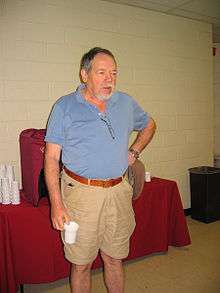Peter J. Freyd
| Peter J. Freyd | |
|---|---|
 | |
| Born |
February 5, 1936 (age 82) Evanston, Illinois[1] |
| Alma mater | Princeton University (Ph.D, 1960) |
| Known for |
Freyd–Mitchell theorem, HOMFLY polynomial, Allegory (category theory) |
| Scientific career | |
| Fields | Category theory |
| Institutions | University of Pennsylvania |
| Doctoral advisors |
Norman Steenrod David Buchsbaum |
Peter J. Freyd (/fraɪd/; born February 5, 1936) is an American mathematician, a professor at the University of Pennsylvania, known for work in category theory and for founding the False Memory Syndrome Foundation.
Mathematical work
Freyd obtained his Ph.D. from Princeton University in 1960; his dissertation, on Functor Theory, was written under the supervision of Norman Steenrod and David Buchsbaum.
Freyd is perhaps best known for his adjoint functor theorem. He was the author of the foundational book Abelian Categories: An Introduction to the Theory of Functors (1964). This work culminates in a proof of the Freyd–Mitchell embedding theorem.
In addition, Freyd's name is associated with the HOMFLYPT polynomial of knot theory, and he and Scedrov originated the concept of (mathematical) allegories.
In 2012 he became a fellow of the American Mathematical Society.[2]
False Memory Syndrome Foundation
Freyd and his wife Pamela founded the False Memory Syndrome Foundation in 1992,[3] after Freyd was accused of sexual abuse by his daughter Jennifer.[3][4] Freyd denies the accusations.[5]
According to a statement made by William Freyd, his brother and Jennifer Freyd's uncle, Freyd and his wife Pamela grew up in the same household as step-siblings.[6] Freyd's brother added that, in his view, "The False Memory Syndrome Foundation is designed to deny a reality that Peter and Pam have spent most of their lives trying to escape," and that he was certain abuse happened to his niece.[7]
Publications
- Peter J. Freyd, Abelian Categories, an Introduction to the Theory of Functors. Harper & Row (1964).[8] Available online.
- Peter J. Freyd and Andre Scedrov: Categories, Allegories. North-Holland (1999). ISBN 0-444-70368-3.
- Freyd Peter J (1999). "Path Integrals, Bayesian Vision, and Is Gaussian Quadrature Really Good?". Electr. Notes Theor. Comput. Sci. 29.
- Freyd Peter J.; O'Hearn Peter W.; Power A. John; Takeyama Makoto; Street R.; Tennent Robert D. (1999). "Bireflectivity". Theor. Comput. Sci. 228 (1–2): 49–76.
Notes
- ↑ American Men and Women of Science, Thompson Gale, 2005
- ↑ List of Fellows of the American Mathematical Society, retrieved 2012-12-29.
- 1 2 Diana E. H. Russell. The Secret Trauma: Incest in the Lives of Girls and Women. Basic Books, 1987. xx–xxi.
- ↑ Freyd, J. (1996) Betrayal Trauma: The Logic of Forgetting Child Abuse. Cambridge, MA: Harvard University Press. The history of the confrontations between the Freyds and their daughter Jennifer is recounted in the Afterword, pages 197–199.
- ↑ "One family's tragedy spawns national group", The Baltimore Sun, September 12, 1994. Available on the web at Skeptic Files
- ↑ Whitfield, C. (1995). Memory and abuse: Remembering and healing the effects of trauma . Deerfield Beach , FL : Health Communications, Inc.
- ↑ Whitfield
- ↑ Linton, F. E. J. (1965). "Review of Abelian categories: an introduction to the theory of functors by Peter Freyd" (PDF). Bull. Amer. Math. Soc. 71 (4): 577–580. doi:10.1090/s0002-9904-1965-11342-8.
External links
- Peter J. Freyd at the Mathematics Genealogy Project
- Printable versions of Abelian categories, an introduction to the theory of functors.